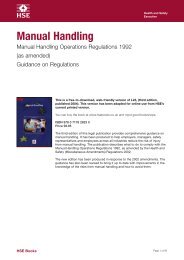Making Companies Safe - what works? (CCA ... - Unite the Union
Making Companies Safe - what works? (CCA ... - Unite the Union
Making Companies Safe - what works? (CCA ... - Unite the Union
You also want an ePaper? Increase the reach of your titles
YUMPU automatically turns print PDFs into web optimized ePapers that Google loves.
• A number of studies evaluating <strong>the</strong> impact of specific health and safety regulations found<br />
that <strong>the</strong>se were generally associated with a change in employer practice amongst those<br />
organisations that were aware of <strong>the</strong>m. 35 For instance;<br />
– Hanson et al.’s 1998 review of <strong>the</strong> Six Pack Regulations found a steady increase in <strong>the</strong><br />
proportion of employers conducting risk assessments from 30 per cent before <strong>the</strong><br />
regulations were introduced in 1992 to more than 80% by 1998.<br />
– Honey et al.’s 1996 evaluation of <strong>the</strong> Noise at Work Regulations found that around<br />
35-40% of employers had introduced ear protection following <strong>the</strong> introduction of <strong>the</strong><br />
legislation.<br />
– Lancaster et al.’s 2001 research found a similar level of impact following <strong>the</strong><br />
introduction of <strong>the</strong> Manual Handling Regulations.<br />
It is clearly crucial that <strong>the</strong> HSC is aware of this research when making decisions on whe<strong>the</strong>r<br />
to pursue a voluntary or regulatory route. Whilst it may be cheaper, easier and more politically<br />
convenient to opt for voluntary routes – <strong>the</strong> evidence certainly indicates that <strong>the</strong>y will not be<br />
effective.<br />
The next two chapters look at <strong>the</strong> extent to which <strong>the</strong> HSC considered this and o<strong>the</strong>r evidence<br />
in making its decisions on Directors Duties and Worker Participation.<br />
22<br />
1 Health and <strong>Safe</strong>ty Commission (2004a: 11).<br />
2 Action point 7.<br />
3 Action point 11.<br />
4 Action point 15.<br />
5 Action point 16.<br />
6 Action point 31.<br />
7 See Action Point 11 of Revitalising Health and <strong>Safe</strong>ty (DETR/ HSC, 2000).<br />
8 Health and <strong>Safe</strong>ty Commission (2003b).<br />
9 See, for instance, Health and <strong>Safe</strong>ty Commission (2000).<br />
10 Health and <strong>Safe</strong>ty Commission (2003a).<br />
11 Confederation of British Industry (2004).<br />
12 Gunningham (1999a: 12).<br />
13 Voluntary codes of conduct are a form of self-regulation for corporations operation in <strong>the</strong> global economy. Workplace codes<br />
may be inspired by, and sometimes incorporate international human rights standards established in <strong>the</strong> conventions and<br />
declarations of <strong>the</strong> ILO and <strong>the</strong> UN, but <strong>the</strong>y are never<strong>the</strong>less entirely voluntary (Human Rights Dialogue, 2000: 1-3). Christian<br />
Aid defines Corporate Social Responsibility (CSR) as: “an entirely voluntary, corporate-led initiative to promote self-regulation<br />
as a substitute for regulation at ei<strong>the</strong>r national or international level” (Christian Aid, 2004: 5).<br />
14 Discussed in Wright et al. (2004: 14).<br />
15 Wright et al. (2004: 14).<br />
16 OECD (2000).<br />
17 See for instance <strong>the</strong> report by Christian Aid (2004).<br />
18 See for instance, Duong (2000) and Banks (2000: 14).<br />
19 Benjamin (2000: 7).<br />
20 Letter from Amnesty International and o<strong>the</strong>r organisations to DTI, 27 May 2004, ‘Consultation on Draft International<br />
Strategic Framework”.<br />
21 The Observer ‘UK’s ‘responsible’ industry credibility blown asunder’, Sunday May 30, 2004.<br />
22 Gunningham (1999a: 24).<br />
23 Discussed in Gunningham (1999a: 24-25).<br />
24 Purvis and Bauler (2004).<br />
25 Benjamin (2000: 7).<br />
26 Christian Aid (2004).<br />
27 OECD (2000: 26, 29).<br />
28 Wright et al. (2004: 7).<br />
29 Hillage et al. (2001: 29); Wright (1998).<br />
30 Hillage et al. (2001: 26).<br />
31 Wright (1998).<br />
32 Ashby S.G. and Diacon S.R. (1996).<br />
33 Baldwin and Anderson (2002: 25).<br />
34 Hillage et al. (2001).<br />
35 Hillage et al. (2001: 26).
















